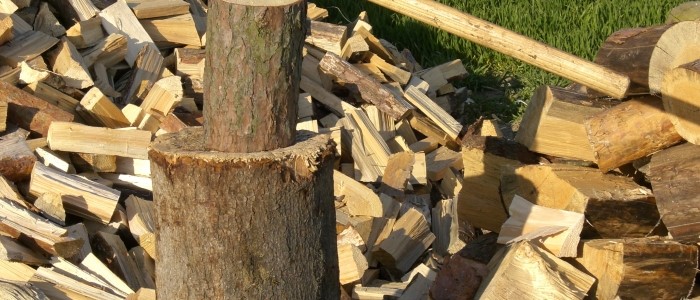For wood-choppers and timber-trimmers alike, chopping wood may come naturally, but with the rising popularity of wood burning stoves, many home owners are also taking to chopping wood in their own hands – especially in the run up to the festive season.
There are numerous of discussion online as to the correct way of approaching this task. But while ‘correct’ seems to be open to interpretation, in this guide, we’ll take you through some of the best ways of preparing your wood.

What you need
Tools: When it comes to your choice of tool, the key isn’t sharpness – you’re not cutting wood or even chopping it (a common misnomer) – you’re splitting wood.
Therefore, a maul, which is heaver and has a wider head than an axe, is superior to splitting wood. However, an axe can work just as well for smaller wood splitting jobs.
If, however, axe-work isn’t your forte, you may want to invest in an engine-driven log-splitter. Log-splitters pretty much deal with anything – including those stubborn timber, such as damp or gnarly elm.
Wood: Generally, it’s easier to split logs that are seasoned (have had excess water/moisture content removed) because the wood fibres break apart more easily when dry.
The technique
Firstly, you’ll want to clear the area you’re working in – which should ideally be outdoors, making sure there’s nothing around that could be damaged by flying wood (or anything else for that matter).
Stand with your legs apart a little, pull the axe straight back over your head, and swing it straight forward. Concentrate on building up speed and let the momentum and weight of the axe do most of the work – not your brute strength.
Aim to hit the blade right in the centre of the wood, but err on the side closer to you. That way, if you miss on the side close to you, the blade will go into the ground. But if you miss on the far side, the axe handle will hit the wood – too much of that and you’ll be buying forking out for a new handle.
Try to hit the same place every time, but you won’t always hit the mark – so don’t worry. You may even get the axe stuck in the wood at times, again this isn’t a problem.
Eventually it will split with a satisfying crack. A few more gentle hits will help separate the remaining strands of wood connecting the pieces of timber together.
The rubber-band trick: A great tip we picked up online will revolutionise the way you chop logs. Simply, wrap a tough rubber band around the log to hold it together, take a sharp axe and then split the wood into sections.
The rubber holds it together, allowing you to finish splitting without sending logs flying and helping you to move it easily – voila!
https://www.youtube.com/watch?v=Y6kI-Afp3_s&feature=youtu.be
The same approach can also be applied with a car tyre:
Stacking wood

So after you’ve done the hard bit, what’s the best way to stack your timber?
Wood will dry best when cut to short lengths, split and left stacked, off the ground. Preferably, with a roof over the top, but it’s advisable to leave the sides open to achieve good air circulation.
The tip is to not stack too tightly. This will allow drying air to get at the logs. Stack with irregularities in the pile, avoiding long vertical seams that might cause the pile to collapse.
Bark-side up or bark-side down? This heated debate mostly boils down to culture. For example, those who live on the coast would prefer the bark to be turned up to keep it drier from the rain. Whereas our Norwegian friends would argue that bark-side down is best to protect it from snow as it builds up from the ground. It is also argued that wood dries more easily when the bark is down.
Some would say there’s an art to stacking wood. Like this amazing construction by sculptor John Van Alstine (pictured right) – incredibly satisfying, don’t you think?
And you?
If you’d like to share some of your advice on chopping wood, we’d love you to add your tips to the woodpile – so don’t hesitate to give us a shout on Twitter.
And if you’re looking for quality timber to kick-start your next project, be sure to check out our fantastic product range today.
